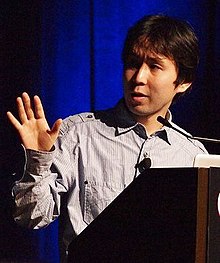This article needs to be updated. (February 2014) |
Daisuke Amaya (天谷 大輔, Amaya Daisuke, born April 29, 1977), also known by his pseudonym Pixel, is a Japanese indie game developer. He is best known for developing Cave Story (洞窟物語, Dōkutsu Monogatari), which has been remade into many versions.
Daisuke Amaya | |
|---|---|
 Pixel speaks at Game Developers Conference. | |
| Born | April 29, 1977 Ono, Fukui, Japan |
| Nationality | Japanese |
| Other names | Pixel, Pi |
| Occupation | Video game developer |
| Known for | Cave Story |
Career
editHis most popular work, Cave Story, is a freeware PC platform game released in 2004 that was created entirely by himself over the period of five years. The game received widespread praise from critics[1][2][3] and in July 2006 appeared at the top of Super PLAY's list of the 50 best freeware games of all time.[4]
Amaya's other work includes the game Ikachan which he released in 2000, as well as many other low-profile games. His current projects, if any, are unknown. Before working on Kero Blaster, he was working on a game titled "Rockfish", which was intended to be finished sometime in 2012.[5] The project was put on indefinite hiatus, and was likely canceled. Amaya was credited with the story concept for Nicklas Nygren's NightSky.[6] In May 2014, Amaya released Kero Blaster, a side-scrolling platform shooter game. This game was Amaya's first major work since the release of Cave Story.[7] In October 2015, Amaya updated Kero Blaster, under the name Kero Blaster ZANGYOU or overtime mode, featuring a new story, levels, and overall greater difficulty.[8] In 2021, Amaya was credited for assisting in the development of MIYAKOpubl's game Haru to Shura.[9]
Audio software
editAmaya has created various audio and music composition software. All his music composition software uses a piano roll editing interface.
Org Maker is the software used to create music for the lightweight Organya (.org) music format, which was used in Cave Story.
He is continuously developing the successor to Org Maker, the freeware audio editing suite PxTone. Users can create their own audio samples and compose music using PxTone Collage.
Games
edit- Ikachan (2000)
- Ikachan 3DS (2013)
- Azarashi (2001)
- Azarashi iOS (2012)
- Glasses (Megane) (2003)
- Cave Story (2004)
- Cave Story Wii (2010)
- Cave Story DSi (2010)
- Cave Story+ (2011)
- Cave Story 3D (2011)
- Cave Story 3DS (2012)
- Guxt (2007)
- NightSky (2011) - story
- Pink Hour (2014)
- Kero Blaster (2014)
- Pink Heaven (2015)
Other works
editStarting in May 5, 2000, Amaya published a 4-koma manga titled Ame Manga on his personal website.[10] The last strip was released on May 31, 2002.
References
edit- ^ Sharkey, Scott (2 February 2005). "Freeloader: Doukutsu Monogatari". 1UP.com. Retrieved 21 May 2009.
- ^ Park, Eddie (12 October 2005). "Doukutsu Monogatari Freeware Available". Inside Mac Games. Archived from the original on 8 January 2009. Retrieved 21 May 2009.
- ^ "The Rise and Fall (and Rise?) of Japan". Electronic Gaming Monthly. September 2008. p. 63.
- ^ "Gratis Topp 50". Super PLAY: 118–121. July 2006.
- ^ Amaya, Daisuke. 開発. 開発 (in Japanese). 開発室 Pixel. Archived from the original on 17 October 2011. Retrieved 9 October 2011.
- ^ Nicalis (6 January 2011). NightSky (Windows). Level/area: Credits.
Story Concept / Daisuke Amaya
- ^ Farokhmanesh, Megan (31 March 2014). "Cave Story dev's new game, Kero Blaster, launches May 11". Polygon. Vox Media. Retrieved 19 May 2014.
- ^ Musgrave, Shaun (12 October 2015). "Studio Pixel Releases Update To 'Kero Blaster' And New Companion Game 'Pink Heaven'". toucharcade. TouchArcade.com LLC. Retrieved 18 February 2016.
- ^ "春と修羅|Haru to Shura". MIYAKOpubl. Retrieved 8 March 2022.
- ^ Amaya, Daisuke. アメまんが. Ame Manga (in Japanese). 開発室 Pixel. Archived from the original on 10 June 2004. Retrieved 30 November 2023.
External links
edit- Daisuke Amaya's personal page (in Japanese)
- Daisuke Amaya's art and gamedev accounts on Twitter
- Challenging Freeware Classic Cave Story Makes Wii Debut, Gus Mastrapa, Wired, March 22, 2010
- Yu, Derek (7 April 2005). "Interview: PIXEL". The Independent Gaming Source. Archived from the original on 12 March 2007. Retrieved 21 May 2009.
- The Cave Story story, The Brainy Gamer, March 29, 2010